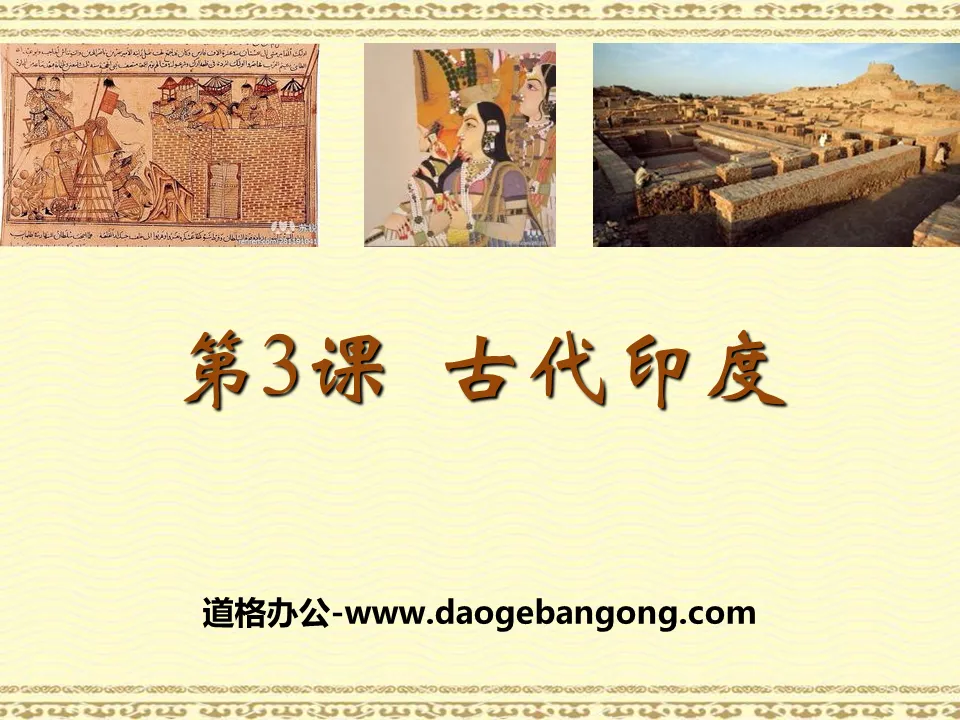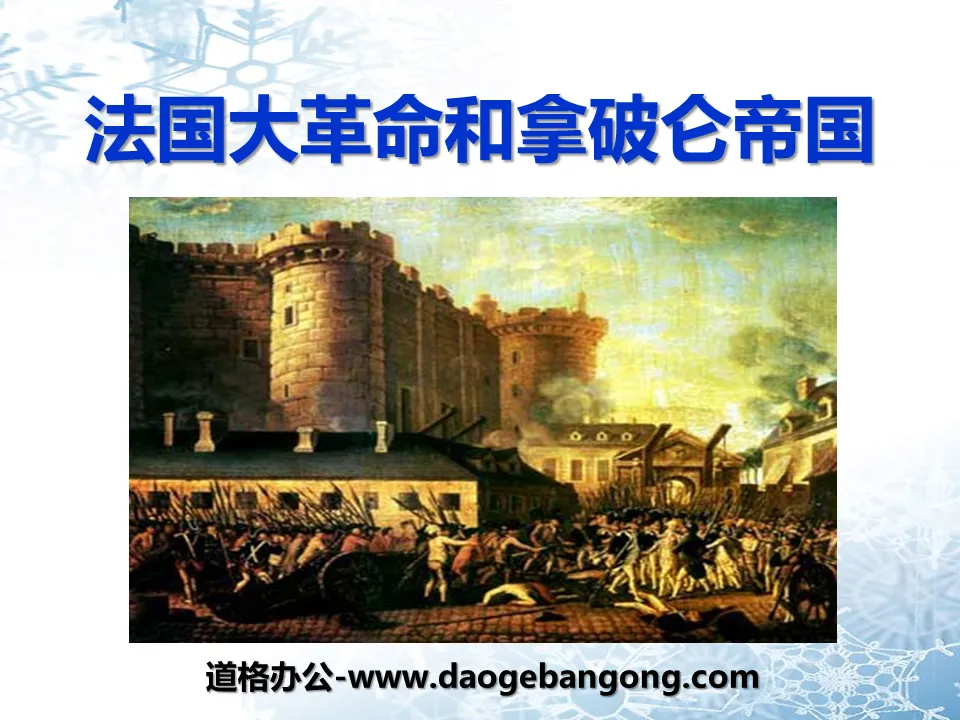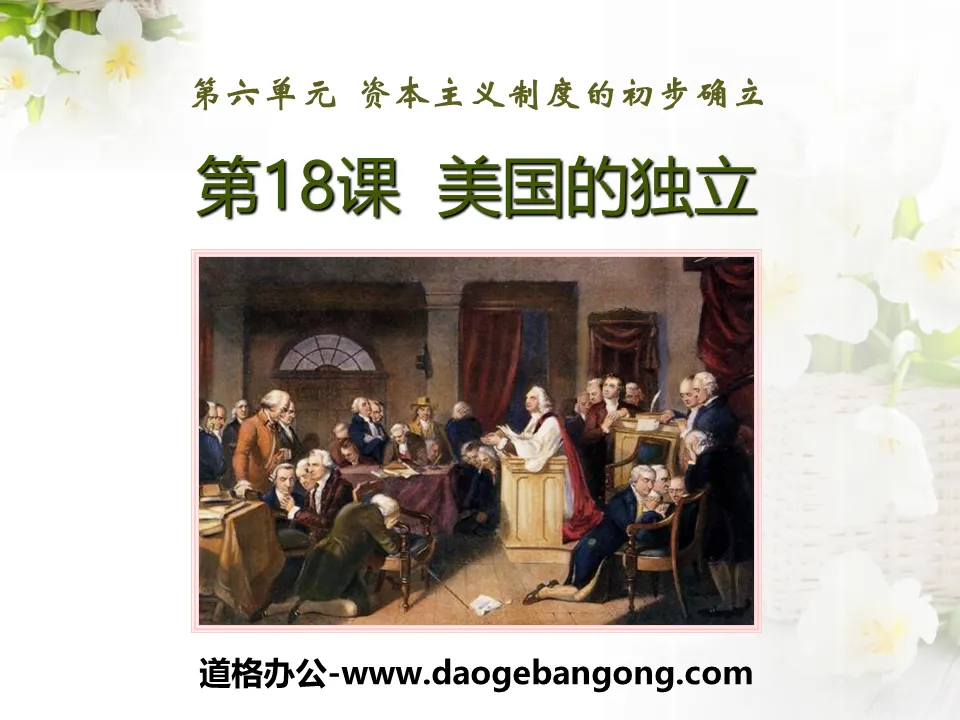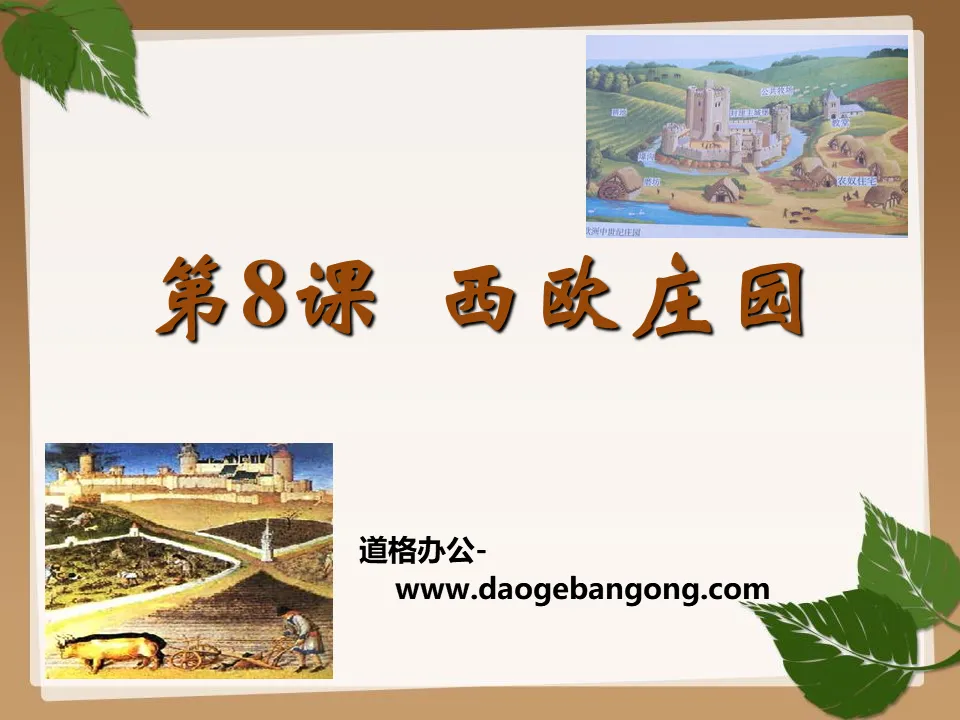
| Category | Format | Size |
|---|---|---|
| People's Education Press Ninth Grade History Volume 1 | pptx | 6 MB |
Description
"Medieval European Society" Feudal Society in Asia and Europe PPT Courseware 7
Curriculum Standards
Through the study of this course, you will learn about the hierarchy of Western European feudal society, the influence of Christianity on Western European society, the rise of Western European cities, and the demise of the Byzantine Empire.
knowledge and abilities
Think about: "What are the characteristics of Western European feudal society" and "The Byzantine Empire once stood tall in the world with its prosperous economy and glorious culture, but why did it later decline?" and cultivate the ability to summarize and analyze historical issues. .
Understand the significance of the re-emergence of Western European cities and compare the similarities and differences between Chinese and Western feudal systems and cities, and learn to use comparative methods to understand historical issues. Use historical data to analyze the reasons for the demise of the Byzantine Empire.
Emotional attitudes and values
Recognize that the transition from slave society to feudal society is the progress of human society; China entered feudal society about 1,000 years earlier than Western Europe, and showed advanced nature in politics, economy, and culture at that time; the demise of the Byzantine Empire illustrates openness and tolerance It leads to the prosperity of civilization, while conservatism and narrow-mindedness weaken it. We must firmly follow the path of reform and opening up and establish the belief in pioneering and innovation.
1. Strictly hierarchical feudal society in Western Europe
The formation and development of the Frankish Kingdom
The Franks are a branch of the Germanic people who settled in the lower reaches of the Rhine River in the 3rd century. The Franks mainly include the Salic and Ripuar tribes, and they are in the stage of primitive clan tribal society. With the decline of the Roman Empire, the Franks gradually penetrated into northeastern Gaul. After Clovis succeeded as the chief of the Salic tribe in 481, he began to expand into Gaul with all his strength, wiping out other Frankish chieftains. In 486, the remaining Western Roman forces in Gaul were defeated, occupied most of Gaul, and established the Merovingian dynasty, with Paris as its capital. Tribal nobles and janissaries became feudal lords, while ordinary Franks became free farmers in rural communes. The local Gallo-Roman nobility, Roman church, peasants, slaves and scattered free farmers still existed, gradually integrating with the Franks. In 496, the Frankish ruling class converted to Christianity and received strong support from the Gallo-Romans.
The Frankish royal family adopted a succession system in which the territory was equally divided among the king's sons after his death, which kept the kingdom in a repeated process of division, melee, and reunification, while at the same time it continued to expand outwards. The power of the feudal lords weakened the royal power, and the power of the kingdom gradually fell into the hands of the palace ministers who controlled palace affairs.
What are the characteristics of the feudal hierarchy in Western Europe?
The land system in Western Europe is based on the relationship between feudal lords and vassals with land as the link. The lord has the responsibility to protect the vassal, and the vassal is also obliged to be loyal and go to the front line to fight at any time. This greatly improves the country's combat effectiveness. The king, feudal lords and the Christian church established a pyramid-like feudal hierarchy in which each other was master and slave through layers of fiefs.
Feudal hierarchy: In European feudal society, each social class had a clear hierarchy and could not be crossed. In the picture, two low-status peasants are making way for two high-status knights.
Investiture ceremony: Land and allegiance were the link between feudal lords and vassals in medieval European society. The investiture ceremony was a testimony of the vassal's allegiance to the lord.
The significance of feudal fiefdom: The form of feudal fiefdom is very helpful in improving the country's combat effectiveness, and through the fiefdom system, a feudal hierarchy is gradually formed.
Pepin offered soil:
In the middle of the 8th century, Pepin, the Frankish palace minister, became the king of the Franks with the support of the Pope. In return, Pepin personally sent troops to Italy and gave the large tracts of land he conquered to the pope. This was known as the "Pepin's Land Offering" in history, thus laying the foundation for the Papal State.
Pepin's Offering of Land and the Establishment of the Papal States
There is the "Vatican City State" on a high ground in the northwest corner of Rome, the capital of Italy. It is the seat of the Catholic Pope and a country that unites politics and religion with the Pope as its leader. It covers an area of only 0.44 square kilometers and has a population of about 1,000 people, 85% of whom are Italians. It is surrounded by high walls and is separated from the city of Rome, but St. Peter's Square in the east is open to the outside. It only takes 45 minutes to walk around it.
In 741 AD, Pepin the Short succeeded his father, served as the palace minister of the Frankish Kingdom, and gained real power. But he was not satisfied and wanted to obtain the highest honor in the kingdom and usurp the throne. He sought support from the pope to make his usurpation of the throne legal. Finally, with the approval and help of the Pope, he achieved the goal of usurping the throne and proclaiming himself king in November 751 AD, establishing the Carolingian dynasty. The newly enthroned Pope Stephen III (752-757 AD) personally went to Gaul to hold religious ceremonies for the new king. The Pope imitated the example of King David (1013 BC - 973 BC), the founder of the Jewish state of Israel recorded in the Bible, and anointed Pepin, his wife and children with holy oil. This ceremony gave the king of the new dynasty a sacred color, indicating that the king was a theocratic king "elected by the grace of God", thus making Pepin's king a representative of God's rule on earth.
2. The re-emergence of Western European cities
Time: 10th century
Many famous cities have arisen in Italy, France, England, Germany, etc.
urban autonomy
Reason: In order to safeguard their own interests and create an environment conducive to the development of the commodity economy;
Purpose: to seize the administrative and judicial power of the city;
Means: Money redemption and armed struggle are two commonly used means;
Result: Some cities gained full or partial autonomy.
Why are Western European cities trying to gain autonomy? Can you tell us about the struggle of the citizens of Langcheng, France, for their autonomy?
Reason: With the development of the commodity economy, feudal lords became increasingly greedy and intensified their exploitation of urban citizens, resulting in increasingly acute conflicts between feudal lords and citizens. In the 11th and 12th centuries, citizens of some cities either used money to redeem themselves or launched armed uprisings in order to get rid of feudal control and win autonomy.
The significance of the re-emergence of cities in Western Europe:
Economic aspect: The city's commodity economy played a disintegrating role in the feudal system from the beginning.
Political aspect: Those cities with freedom and autonomy became new political entities. They united with the royal power to deal with the great nobles. The urban citizen class continued to grow and became the predecessor of the modern bourgeoisie.
Ideological and cultural aspects: With the improvement of the political and economic life of the citizen class, a new concept of secular life gradually formed, which laid the foundation for the Renaissance and religious reform movements that later emerged.
3. Byzantine Empire
The Byzantine Empire or Eastern Roman Empire was the eastern half of the Roman Empire that survived the collapse of the Western Roman Empire. The Byzantine Empire is generally considered to have lasted from 395 to 1453 AD (actually beginning in the eighth century). During its thousands of years of existence it was generally known simply as the "Roman Empire".
The name Byzantium originally originated from an ancient Greek immigrant city near the sea. In 330 AD, the Roman Emperor Constantine I built the city here as the capital of the Roman Empire and renamed it Constantinople. Constantinople is located on the Bosporus, a strategic waterway connecting the Black Sea to the Aegean Sea. It restricts the main sea and land commercial routes and has a very advantageous geographical location. In 395 AD, the huge Roman Empire was invaded by various barbarians and was divided into two parts for the convenience of administration. The Eastern Empire had Constantinople as its capital, so the Eastern Roman Empire was also called the Byzantine Empire.
In 476 AD, the Western Roman Empire finally breathed its last breath after experiencing repeated attacks by the Huns and many Germanic tribes. Byzantium became the only Roman empire - in fact, they have always regarded themselves as pure Roman blood.
Important events in the Byzantine Empire
In 330 AD, Emperor Constantine moved the capital to Constantinople.
527 Justinian I becomes emperor.
From 532 to 537, Justinian I built the "Cathedral of Sophia".
1054 Schism: The Church of Constantinople breaks away from the Holy See and becomes the Greek Orthodox Church.
1204 Crusades: Constantinople is captured by the Crusaders.
1261 Byzantine Emperor Michael VIII Paliologas liberates Constantinople.
In 1453, the Ottoman Turks captured Constantinople and the Byzantine Empire fell.
Reasons for the decline of the Byzantine Empire
1. After the 6th century, there were conquests everywhere, the wealth was exhausted, the people were impoverished, and foreign invasions continued.
2. It was conquered by Western armies in the first half of the 13th century
3. In the mid-15th century, it was destroyed by the Ottoman Turks.
Consolidation exercises
1. Answer the questions based on the materials:
"The vassal of my vassal is not my vassal"
Please answer:
(1) Please explain the meaning of material?
Answer: Each lord can only govern his own vassals, but has no right to govern his own vassals.
(2) Which system does the material reflect? Which reform in history did this system originate from?
Answer: Hierarchy. The Reformation of Charles Martel.
Keywords: Feudal Society Teaching Courseware in Asia and Europe, Teaching Courseware on Medieval European Society, PPT courseware download for the first volume of the ninth grade history of the People's Education Press, Download slideshow courseware on history for the ninth grade, Download PPT courseware on the feudal society in Asia and Europe, Medieval European Society PPT courseware download, .PPT format;
For more information about the PPT courseware "Feudal Society in Asia and Europe and Medieval European Society", please click the Feudal Society in Asia and Europe ppt Medieval European Society ppt tag.
"Medieval European Society" Feudal Society in Asia and Europe PPT courseware 8:
"Medieval European Society" Feudal Society in Asia and Europe PPT Courseware 8 Roman Empire (Octavian proclaimed himself emperor in 27 BC across Europe, Asia and Africa) The Roman Empire was divided (395) The Western Roman Empire was destroyed (the slave society in Western Europe ended in 476) 1. Strict hierarchy..
"Medieval European Society" Feudal Society in Asia and Europe PPT courseware 6:
"Middle Ages European Society" Feudal Society in Asia and Europe PPT courseware 6 Three knowledge points 1. Strictly hierarchical feudal society in Western Europe 2. The re-emergence of Western European cities 3. The demise of the Byzantine Empire Strictly hierarchical feudal society in Western Europe 1. Frank Establishment of the Kingdom: 5..
"Medieval European Society" Feudal Society in Asia and Europe PPT courseware 5:
"Medieval European Society" Feudal Society in Asia and Europe PPT Courseware 5 1. The Medieval period refers to the period between the demise of the Western Roman Empire in 476 and the outbreak of the British bourgeois revolution in 1640. 2. What is medieval history? Medieval history is also called medieval history, which refers to...
File Info
Update Time: 2024-07-09
This template belongs to History courseware People's Education Press Ninth Grade History Volume 1 industry PPT template
"Medieval European Society" Feudal Society in Asia and Europe PPT Courseware 7 Simple campus recruitment activity planning plan summary enterprise and institution recruitment publicity lecture PPT template is a general PPT template for business post competition provided by the manuscript PPT, simple campus recruitment activity planning plan summary enterprise and institution recruitment promotion Lecture PPT template, you can edit and modify the text and pictures in the source file by downloading the source file. If you want more exquisite business PPT templates, you can come to grid resource. Doug resource PPT, massive PPT template slide material download, we only make high-quality PPT templates!
Tips: If you open the template and feel that it is not suitable for all your needs, you can search for related content "Medieval European Society" Feudal Society in Asia and Europe PPT Courseware 7 is enough.
How to use the Windows system template
Directly decompress the file and use it with office or wps
How to use the Mac system template
Directly decompress the file and use it Office or wps can be used
Related reading
For more detailed PPT-related tutorials and font tutorials, you can view: Click to see
How to create a high-quality technological sense PPT? 4 ways to share the bottom of the box
Notice
Do not download in WeChat, Zhihu, QQ, built-in browsers, please use mobile browsers to download! If you are a mobile phone user, please download it on your computer!
1. The manuscript PPT is only for study and reference, please delete it 24 hours after downloading.
2. If the resource involves your legitimate rights and interests, delete it immediately.
3. Contact information: service@daogebangong.com
"Medieval European Society" Feudal Society in Asia and Europe PPT Courseware 7, due to usage restrictions, it is only for personal study and reference use. For commercial use, please go to the relevant official website for authorization.
(Personal non-commercial use refers to the use of this font to complete the display of personal works, including but not limited to the design of personal papers, resumes, etc.)
Preview




















